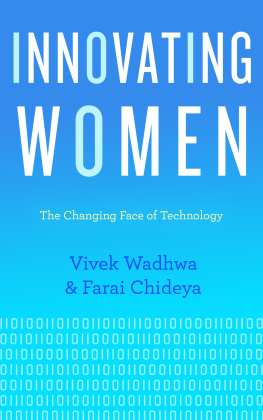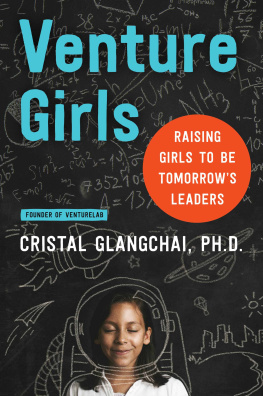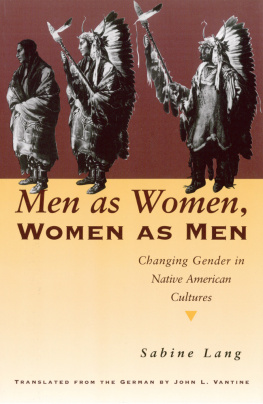Copyright
Diversion Books
A Division of Diversion Publishing Corp.
443 Park Avenue South, Suite 1008
New York, NY 10016
www.DiversionBooks.com
Copyright 2014 by Vivek Wadhwa
All rights reserved, including the right to reproduce this book or portions thereof in any form whatsoever.
For more information, email
First Diversion Books edition September 2014
ISBN: 978-1-62681-383-0
Introduction
At the 2009 TechCrunch Crunchies Awardsthe Oscars of the tech industrymy wife, Tavinder, asked a question that confused me. Vivek, do you notice something strange?
Yes, I whispered excitedly. Mark Zuckerberg is sitting next to us.
She smiled indulgently and said, Try again.
I looked around and said, All the celebrities are dressed in ragged jeans and T-shirts?
No, Vivek, she said. Where are the women?
That one comment opened my eyes to an ugly reality: just as no women were featured on stage at the Crunchies other than the TechCrunch staff and one circus performer, the entire tech world was male-dominated. Suddenly I saw that the place Id been touting as the worlds greatest meritocracy had deep-rooted biases, which were systematically discriminating against the most innovative half of our population.
For years, I had been researching entrepreneurship, immigration, and what made Silicon Valley tick. With the help of noted academics, such as UC Berkeley dean AnnaLee Saxenian and Harvard economist Richard Freeman, my research teams at Duke University had published several groundbreaking academic papers. But I was so oblivious to the issue of gender that I didnt even record the sex of the thousands of entrepreneurs we had researched. Just as I hadnt noticed the gender gap at the TechCrunch event, it hadnt even occurred to me that there could be differences between male and female entrepreneurs.
I was ignorant.
I started looking at Silicon Valley from this new perspective, and I saw that the executive teams of the Valleys top tech firms had very few, if any, women technology heads. The entire management team of Apple didnt have a single woman. Virtually all of Silicon Valleys investment firms were male-dominated. The few women found on their websites were either in marketing or human resources. Venture capital firms, or VCs, were the worst offendersof the eighty-nine VCs on the 2009 TheFunded.com list of top VCs, only one was a woman.
I began to take note of the myths and flaws and harmful stereotypes that are commonly propagated by the technology industrys power brokers. One such comment was from a legendary venture capitalist who I have always held in the highest regard and who I dont believe is sexist. Yet he said at a major conference:
In the early days, when you went back in the Amazon shipping area, the books were lined up so you could see what people were buying. Invariably there was a book about programming language like Java, and in the same sales order, there was a book like The Joy of Sex. These [customers] were probably very clearly male, nerds who had no social or sex lives trying to get help by using an online service.
That correlates more with any other success factor that Ive seen in the worlds greatest entrepreneurs. If you look at [Amazon founder Jeff] Bezos, or [Netscape Communications Corporation founder Marc] Andreessen, [Yahoo! Inc. cofounder] David Filo, the founders of Google, they all seem to be white, male, nerds whove dropped out of Harvard or Stanford, and they absolutely have no social life. So when I see that pattern coming inwhich was true of Googleit was very easy to decide to invest.
There was no public outcry about these comments, no apology, no retraction. In other industries, there would have been an uproar, but in tech, discrimination on sex, race, and age was considered acceptable.
VCs commonly claimed they knew an entrepreneur when they saw one. And sadly, it wasand still isacceptable for venture capitalists to openly tout their supposed pattern recognition abilities. But the patterns they saw were always young, white, male nerds resembling the founders aboveand the VCs themselves. As such, pattern recognition is nothing more than a legitimized way of discriminating against women and minorities, which has no place in business or society in this day and age.
There is innovationthe spark that prompts an idea, concept, or company. And then there is implementationwhich requires capital. And that is what skews the gender balance even more. Implementing ideas hasso farrequired significant amounts of capital. Venture capitalists have controlled access to this capital.
As tech guru and angel investor Esther Dyson explains, VCs tend to invest in people who look like themselves, whether its color, whether its gender, whether its social class. Its hard to know who can be successful, so they tend to work with the familiar, and that leaves out most women, she said.
To get a better understanding of the root of the gender problem, I decided to reanalyze data from my own studies on entrepreneurship. I did web searches and made phone calls to verify the gender of several hundred entrepreneurs whom my team had researched, and I was surprised to learn that there was virtually no difference between successful male and female entrepreneurs. Their motivations were practically identical, as were their education levels, success factors, and reasons for starting a business. They had even learned the same lessons from their past successes and failures.
The only difference was that women placed a higher value than men did on their business partners and on their personal and professional networks. This made me wonder whether women were really cut out for the rough-and-tumble, self-involved world of entrepreneurship. So I reviewed data revealed that women-led, high-tech startups had lower failure rates than those led by men.
I then considered whether a difference in educational backgrounds could be a factor. Not at all, I learned. Data from the National Science Foundation showed that girls now matched boys in mathematical achievement. In the United States alone, 140 women enrolled in higher education for every 100 men. Women earned more than 50 percent of all bachelors and masters degrees and nearly 50 percent of all doctorates.
This led me to address the gender imbalance in a regular blog that I was writing for TechCrunch in 2010, Silicon Valley: You and Some of Your VCs have a Gender Problem. I was surprised at the intensity of the response I received in a barrage of hate mail, immature online chatter, and personal attacks on me over Twitter. I was further stunned to receive e-mails from highly respected VCswho I used to call my friends. One asked what my agenda was in bringing up an issue like this. Another warned that this was not the way to achieve success in the Valley. Another asked whether I was trying to get laid and suggested there were better ways.
A month later, a prominent Silicon Valley investor tweeted that he disagree[s] with [all] TC [TechCrunch] posts Ive ever read by Vivek Wadhwa and that his posts are garbage. One investor tweeted: mystified that he gets visibility & access to public platforms - has anyone ever tested his positions? Watch him on bloomberg. Lawd! Another wrote, He is misrepresenting the data. And that is why he is a loser and no, he is a fraud.
Being new to Silicon Valley and having already been embroiled in nasty debates with nativists over my research on and supportive views of skilled immigration, I was reluctant to pick a fight with Silicon Valleys moguls. Tavinder and I had just decided to move permanently to the Bay area, and I didnt want to make enemies in my new home. She had sacrificed her own career so that she could support mine and had been by my side through all of my ups and downs. When I had a life-threatening heart attack in 2002, the doctors werent sure whether I would make it, but she wouldnt let me die. She stayed at my bedside in the ICU, not sleeping, for three and a half days. She is the secret of my success and the person I go to whenever I have any ethical or moral dilemmas. After my heart attack, the doctors didnt want me to go back to my stressful job as CEO of a technology company, so Tavinder insisted I do something else I was passionate about. I decided to teach and become a mentor to students. I would be earning a fraction of my former salary, but she said we would downsize and manage with less. And on the women-in-technology front, she gave me clear marching orders.







